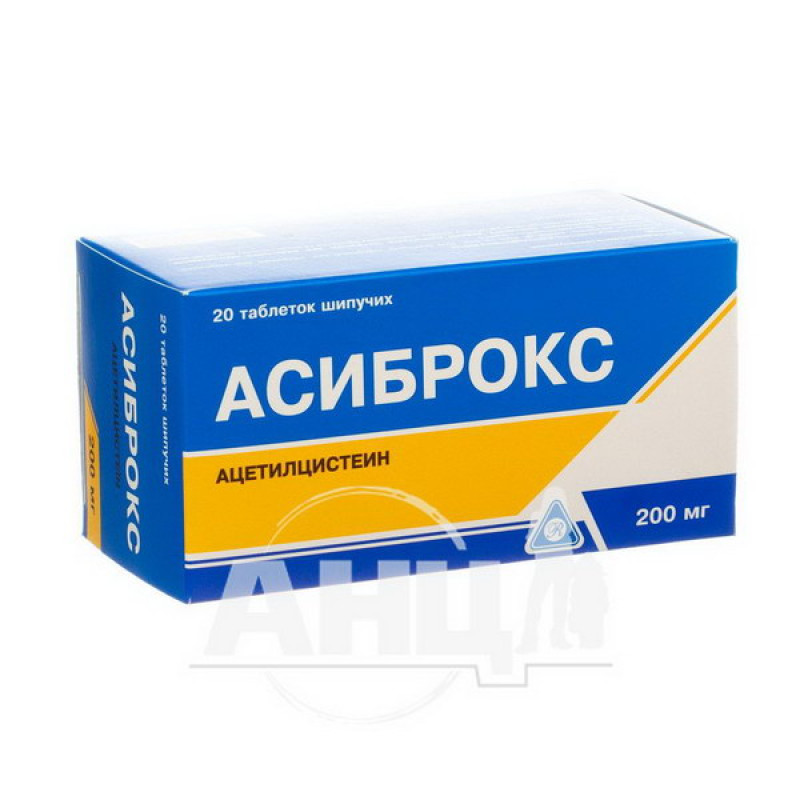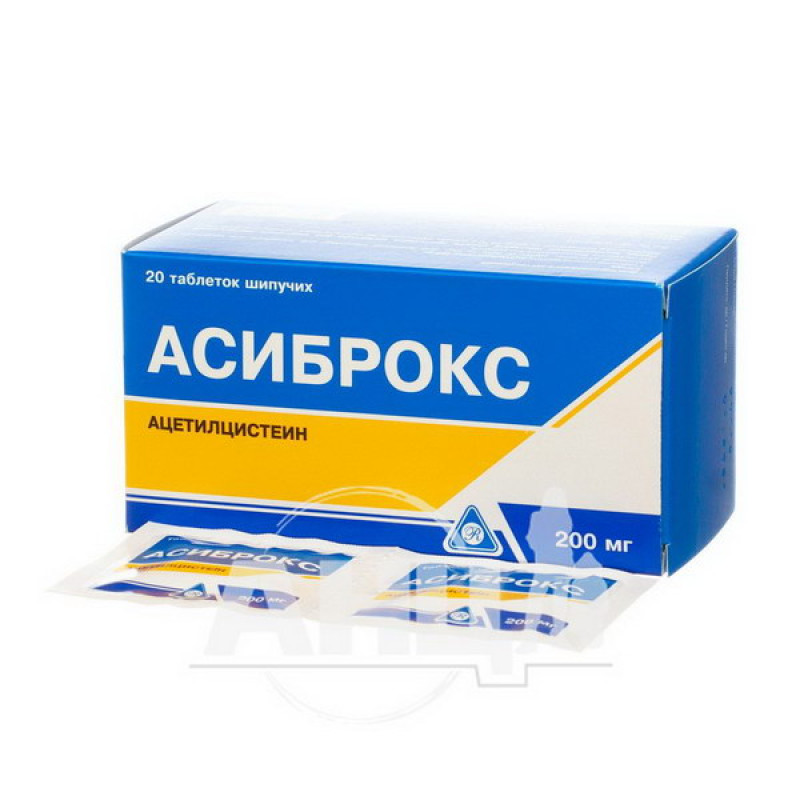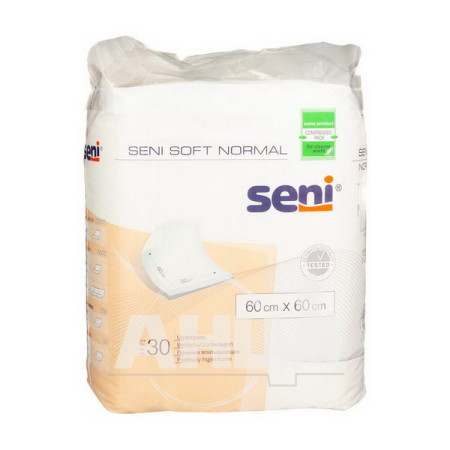Asibrox effervescent tablets 200 mg strip No. 20

Pharmacological properties
Pharmacodynamics. N-acetylcysteine has a mucolytic effect. The presence of sulfhydryl groups in the structure of acetylcysteine contributes to the rupture of disulfide bonds of acidic mucopolysaccharides of sputum, which leads to depolarization of mucoproteins and a decrease in mucus viscosity. The drug retains activity in the presence of purulent sputum.
Moreover, acetylcysteine has a direct antioxidant effect due to the presence of a free thiol (-SH) nucleophilic group, which easily interacts with electrophilic groups of oxidative radicals. In particular, of interest are recent data that acetylcysteine protects α-antitrypsin, a protein that inhibits elastase, from destruction by perchloric acid, a strong oxidizing agent produced by the myeloperoxidase protein of activated phagocytes.
Therefore, acetylcysteine can be used to treat patients with acute and chronic diseases of the respiratory system, accompanied by thick and viscous secretions.
Due to its molecular structure, acetylcysteine can easily penetrate cell membranes. Inside the cell, acetylcysteine is deacetylated to L-cysteine, an amino acid that is necessary for the synthesis of glutathione.
Glutathione is a highly reactive tripeptide that is a pronounced factor of intracellular protection not only against oxidative toxins of both exogenous and endogenous origin, but also against a number of cytotoxic substances.
Pharmacokinetics. Acetylcysteine is completely absorbed after oral administration. Due to metabolism in the intestinal wall and the first-pass effect, the bioavailability of acetylcysteine when taken orally is very low (≈10%). C max in blood plasma is achieved 1-3 hours after administration and they remain higher for 24 hours. Acetylcysteine is distributed both in unchanged form (20%) and in the form of metabolites (80%), mainly distributed in the liver, kidneys, lungs and bronchial secretions.
The volume of distribution of acetylcysteine is from 0.33 to 0.47 l/kg body weight. Protein binding is ≈50% 4 hours after administration and decreases to 20% after 12 hours.
Acetylcysteine is rapidly metabolized in the intestinal walls and liver after oral administration.
About 30% is excreted by the kidneys. T ½ of acetylcysteine is 6.25 hours.
Indication
Mucolytic agent for the treatment of acute and chronic diseases of the bronchopulmonary system, accompanied by increased sputum formation.
Application
Tablets of 200 mg
adults:
400-600 mg/day in 2-3 doses depending on clinical conditions.
Children aged:
2-6 years - 200-400 mg/day in 1-2 doses;
6-12 years - 400-600 mg/day in 2-3 doses, depending on clinical conditions.
12 years - doses as for adults.
The duration of the treatment course is determined individually by the doctor, depending on the nature of the disease (acute or chronic).
Caution for patients on a controlled sodium diet: Each effervescent tablet contains 191 mg of sodium.
Tablets of 600 mg
Adults and children over 14 years of age - 1 effervescent tablet once a day (equivalent to 600 mg of acetylcysteine per day).
Caution for patients on a controlled sodium diet: Each effervescent tablet contains 150 mg sodium.
In acute uncomplicated diseases, the drug is used for no more than 4-5 days without medical supervision.
The period of treatment of chronic diseases is determined by the doctor. The drug is recommended to be taken after meals. Effervescent tablets are dissolved in ½ cup of water, juice or cold tea. When dissolving acetylcysteine, it is necessary to use glassware, avoid contact with metal and rubber surfaces. Do not mix this solution with other drugs. To enhance the mucolytic effect of acetylcysteine, additional fluid intake is recommended.
Contraindication
Hypersensitivity to the active substance or to any of the excipients. Gastric and duodenal ulcers in the acute stage, hemoptysis, pulmonary hemorrhage.
Side effects
Immune system disorders: hypersensitivity reactions, anaphylactoid reactions, anaphylactic shock, angioedema.
From the nervous system: headache.
On the part of the organ of hearing: ringing in the ears.
Cardiovascular system: tachycardia.
Vascular disorders: hemorrhages.
From the respiratory system: bronchospasm, shortness of breath.
On the part of the digestive system: stomatitis, abdominal pain, nausea, vomiting, diarrhea, dyspepsia.
Skin and Appendages: urticaria, rash, angioedema, itching.
General disorders: hyperthermia, facial edema.
Research results: decreased blood pressure.
Very rarely, cases of anemia have been reported. In rare cases, skin reactions such as Stevens-Johnson syndrome and Lyell's syndrome are possible.
Cases of decreased platelet aggregation have been reported, but the clinical significance of this has not been determined.
Special instructions
The use of acetylcysteine, especially at the beginning of treatment, can cause liquefaction of bronchial secretions and increase their volume. If the patient is unable to cough up sputum effectively, postural drainage and bronchial aspiration are necessary. A slight sulfurous odor is not a sign of a change in the drug, but is specific to the active substance. The sodium content should be taken into account in patients on a controlled sodium diet.
This medicinal product contains sorbitol. If you have been told by your doctor that you have an intolerance to some sugars, contact your doctor before taking this medicinal product.
Use during pregnancy and breastfeeding. During pregnancy and breastfeeding, the use of acetylcysteine is possible only if the expected benefit to the mother outweighs the potential risk to the fetus/child.
Children. 200 mg tablets are used in children from 2 years of age. 600 mg tablets are used in children from 14 years of age.
The ability to influence the reaction rate when driving vehicles or working with other mechanisms. No data.
Interactions
The use of antitussives simultaneously with acetylcysteine may increase sputum congestion due to suppression of the cough reflex.
When used simultaneously with antibiotics such as tetracyclines (except doxycycline), ampicillin, amphotericin B, their interaction with the thiol group of acetylcysteine is possible, which leads to a decrease in the activity of both drugs. Therefore, the interval between the use of these drugs should be at least 2 hours.
The simultaneous use of acetylcysteine and nitroglycerin may lead to increased vasodilator and antiplatelet effects of the latter.
Activated charcoal reduces the effectiveness of acetylcysteine.
It is not recommended to dissolve acetylcysteine in the same glass with other drugs. Acetylcysteine reduces the severity of the toxic effect of paracetamol.
Effect on laboratory tests. Acetylcysteine may interfere with colorimetric tests for salicylates and the determination of urates and ketone bodies.
Overdose
There are no data on cases of overdose of acetylcysteine dosage forms intended for oral administration.
Acetylcysteine, when administered at a dose of 500 mg/kg/day, does not cause signs and symptoms of overdose.
Symptoms: Overdose may manifest as gastrointestinal symptoms such as nausea, vomiting and diarrhea.
Treatment. There is no specific antidote for acetylcysteine poisoning; therapy is symptomatic.
Storage conditions
In a dark place at a temperature not exceeding 25 °C.
There are no reviews for this product.
There are no reviews for this product, be the first to leave your review.
No questions about this product, be the first and ask your question.












